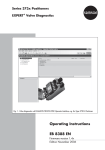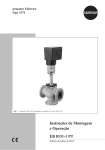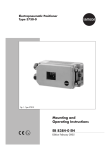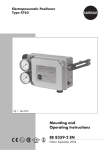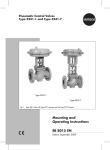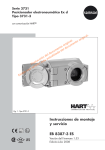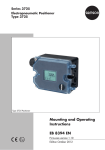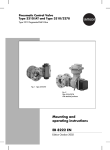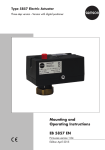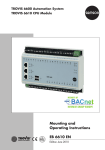Download Mounting and Operating Instructions EB 8388-1
Transcript
Series 3730 Electropneumatic Positioner Type 3730-3 ESD Version ® With HART communication Fig. 1 · ESD mode in SAMSON TROVIS-VIEW 3 software Mounting and Operating Instructions EB 8388-1 EN Firmware version 1.4x Edition November 2006 Contents Contents 1 1.1 1.2 1.3 1.3.1 1.3.2 1.3.3 Description. . . . . . . . . . . General . . . . . . . . . . . . ESD functions . . . . . . . . . Presetting the positioner. . . . . Converting TROVIS-VIEW 3. . . Unlocking the positioner . . . . Printing the diagnostic/ESD log . 2 2.1 2.1.1 2.2 2.2.1 2.3 2.4 2.5 ESD functions . . . . . . . . . . . . . . . . . . . . . . . . . . . . . 8 Changing ESD parameters and starting the partial stroke test . . . . . . 12 On-site operation . . . . . . . . . . . . . . . . . . . . . . . . . . . 13 Analyzing measured data . . . . . . . . . . . . . . . . . . . . . . . 13 Condensed state/Fault alarm output . . . . . . . . . . . . . . . . . . 14 Measured data . . . . . . . . . . . . . . . . . . . . . . . . . . . . 15 Resetting ESD . . . . . . . . . . . . . . . . . . . . . . . . . . . . . 15 List of ESD parameters. . . . . . . . . . . . . . . . . . . . . . . . . 16 3 EXPERT test functions . . . . . . . . . . . . . . . . . . . . . . . . . 19 4 Notes on applications. . . . . . . . . . . . . . . . . . . . . . . . . 20 2 . . . . . . . . . . . . . . . . . . . . . . . . . . . . . . . . . . . . . . . . . . . . . . . . . . . . . . . . . . . . . . . . . . . . . . . . . . . . . . . . . . . . . . . . . . . . . . . . . . . . . . . . . . . . . . . . . . . . . . . . . . . . . . . . . . . . . . . . . . . . 3 3 4 5 5 6 7 + EB 8388-1 EN Description 1 Description The Type 3730-3 Positioner in ESD version is based on the Type 3730-3 Positioner with HART® Communication. These mounting and operating instructions, EB 8388-1 EN, supplement EB 8384-3 EN and focus on the ESD functions. Technical data, attachment, electrical and pneumatic connections as well as operation and the standard EXPERT valve diagnostics are dealt with in Mounting and Operating Instructions EB 8384-3 EN. Note! The optional external position sensor cannot be used with the Type 3730-3 Positioner in ESD version. Extended EXPERT+ valve diagnostics are described in EB 8388 EN. By default, all positioners in ESD version include the EXPERT+ valve diagnostic functions. Note! Positioners delivered not mounted on an actuator are configured with the default settings, which means that the ESD functions are not activated. After mounting the positioner on a safety shut-off valve and starting it up, switch the positioner to ESD mode to allow it to perform the safety functions (for required settings and instructions, see section 2 and EB 8384-3 EN). 1.1 General Note! When the ESD function is active, the positioner keeps the attached valve to a set position, e.g. open. The valve does not perform any control tasks anymore. In AUTO operating mode, the positioner can be used to control the attached valve. ESD (Emergency ShutDown) is a positioner function with extended firmware and partial stroke testing for the predictive, status-oriented detection of malfunctions in pneumatic shut-off valves in safety instrumented systems (SIS). As a result, the probability of failure on demand (PFD) can be reduced and maintenance intervals can be extended. All testing and diagnostic functions are completely integrated into the positioner. The measured data and test results are collected and stored in the positioner. Partial stroke tests can be started and cancelled either manually at any time (on site or using an engineering tool) or automatically according to a certain schedule. A test status is determined at the end of a partial stroke test, which allows operators to directly see whether the test has been completed successfully or not. When the test has not been completed successfully, possible causes of the fault are given. Apart from being indicated on the positioner’s display or in the engineering tool used, the test status is also issued at the fault alarm output. EB 8388-1 EN 3 Description Operation Partial stroke test The positioner can be operated on site using the rotary pushbutton (see section 2.1.1 “On-site operation“). Alarms are indicated on the LCD and issued over the fault alarm output (condensed status). The partial stroke test integrated into the positioner can prevent a normally open valve or a valve in its end position from seizing up or getting jammed. The TROVIS-VIEW 3 software allows for convenient operation when communicating through the SAMSON SSP interface protocol. Thanks to DD and the FDT/DTM concept, the ESD functions can easily be integrated into the process control system or asset management system. The instructions concerning operation in the following sections refer to operation with TROVIS-VIEW 3. Note! All parameter settings entered in the user interface need to be downloaded to the positioner to become effective. 1.2 ESD functions ESD mode In ESD mode, the safety shut-off valve is moved to a specific set point within its working range. The valve does not perform any control tasks anymore. The valve is fully closed in case of an emergency. In its basic setting, the positioner behaves similar to a solenoid valve, which keeps the attached valve to a set position, e.g. open. For test purposes, the partial stroke test can either be started manually (ESD Man) or triggered automatically according to schedule (ESD Auto). 4 EB 8388-1 EN As the course of the partial stroke test is plotted, the dynamic control response can also be analyzed. During the test, the valve is moved out of the end position or from a start value either in steps or in a ramp function until it reaches a defined final value. Then, the valve is moved back again to its initial position. The partial stroke test is performed, for example between 10 and 15 % of the rated travel, starting from the end position while the plant is running, yet without disrupting plant operation. The start and stop values for the partial stroke test can be configured by the user. The following test cancellation conditions provide additional protection against the valve slamming shut and moving past the final value: 4 Valve position x 4 Drive signal y 4 Maximum test time is exceeded 4 Tolerance range exceeded The course of the controlled variable x, reference variable w, setpoint deviation e, and drive signal y parameters is saved in the positioner, assigned to the operating hours counter. The dead time, T63, T98, overshooting, rise time, and response time parameters of a step response test are analyzed separately Description for the increasing and decreasing characteristic. 1.3 The analyses of the last three partial stroke tests are saved in the positioner with the associated time stamp. 1.3.1 Converting TROVIS-VIEW 3 The EXPERT+ test functions Data logger and Hysteresis test to detect friction changes are also available in ESD mode (see section 3 and EB 8388 EN). Note! The valve position is used as the valve travel condition by the data logger of positioners in ESD version. Presetting the positioner The TROVIS-VIEW 3 version must match the software version of the positioner. When establishing communication or exchanging data between the PC and the positioner, the firmware version is checked automatically and the appropriate TROVIS-VIEW 3 module is loaded. To adapt the TROVIS-VIEW 3 version before transmitting data proceed as follows: 1. In the File menu, select Convert. A window listing all available firmware versions is opened. 2. Select “Version 1.xx-1.xx ESD”. 3. Confirm selection with OK. TROVIS-VIEW 3 switches to the user interface for the positioner in ESD version. EB 8388-1 EN 5 Description 1.3.2 Unlocking the positioner To prevent unauthorized access, the positioner settings cannot be changed unless the valid ESD code has been entered. The positioner needs to be unlocked separately for on-site operation and operation through TROVIS-VIEW depending on the operating mode. Entering the code in TROVIS-VIEW 3 1. In the Device menu, select ESD enabling code. TROVIS-VIEW 3 establishes a connection with the positioner. 2. Enter the code in the Value field. The ESD code can be found on page 21. Remove the code or make it unreadable to prevent unauthorized use. Entering the code on the positioner Default: OFF Turn → Code 3 Press . → ON Turn Press → ESD code Turn Press 6 . Display shows: 0 . Display shows: ON, EB 8388-1 EN 3. Confirm selection with OK. Description 1.3.3 Printing the diagnostic/ESD log The Print command allows you to print out a diagnostic log of individual tests or the entire diagnosis. the context-sensitive menu to print the diagnostic log. The printout contains the contents of the folder and its subfolders. The diagnostic log includes a title page and a list of all the data points including all their values and properties. The title page contains all key information for clear identification of the printed log (device type, file name, time and date of creation, time and date of the last change and TROVIS-VIEW version). Select Print in the File menu to add further information. 1. In the File menu, select Print Options to choose the scope of the diagnostic log. After installing/updating the TROVIS-VIEW software, customer data (Customer data in the Edit menu) and summary (table of contents) are listed in the diagnostic log by default. Check the check boxes for the Comments and Graphics options to add these options to the diagnostic log. 2. Right-click the [Diagnosis] folder or the required subfolder and select Print from EB 8388-1 EN 7 ESD functions 2 ESD functions TROVIS-VIEW 3: [Diagnosis > Emergency Shut Down] In TROVIS-VIEW 3, the functions of the positioner in ESD mode are listed in the [Diagnosis] folder under Emergency Shut Down. They include: Activating/deactivating ESD mode and starting the partial stroke test Setting the parameters for partial stroke testing Defining the cancellation conditions for partial stroke testing 4 4 4 Note! Instructions on how to change parameters and start the partial stroke test can be found in section 2.1 “Changing ESD parameters and starting the partial stroke test“. ESD mode ESD mode is active if the Target mode parameter in the [Positioner] folder under Operating mode is set to “Emergency Shut Down“ and Desired ESD mode parameter in the [Diagnosis] folder under Emergency Shut Down is set to “On“. 8 EB 8388-1 EN In ESD mode, the safety shut-off valve is specifically moved to the set point of the valve working range (parameter: Required manual reference variable w). The positioner behaves similar to a solenoid valve, which keeps the attached valve to a set position, e.g. open. The valve does not perform any control tasks anymore. The current valve position is indicated under Manual reference variable w. The ESD operating mode parameter sets the conditions for starting the partial stroke test: Test started manually (ESD Man) ESD operating mode parameter = ESD Man Partial stroke testing begins when triggered by the Start step response parameter. Otherwise, the valve remains in the position defined by the Required manual reference variable w parameter. Changes to the parameters can only be made in ESD Man mode. ESD functions Test started automatically according to schedule (ESD Auto) ESD operating mode parameter = “ESD Auto“ Partial stroke tests are conducted at regular intervals. The Time until the next automatic ESD test parameter indicates when the next test is scheduled (countdown). Partial stroke test The course of the partial stroke test depends on the parameters listed under Settings in TROVIS-VIEW 3. Depending on the parameter settings, the partial stroke test is conducted either in steps or in a ramp function of the valve position (see Fig. 2). After being triggered, the test does not start until the Settling time before test start (t1) has elapsed. This waiting period ensures that the valve has reached the position defined by the Step start parameter (pos. 2, see Fig. 2) before the test starts. Starting from the Step start position (pos. 2), the valve moves to the defined end position (Step end parameter, pos. 3). The valve remains in this position for the time defined by the Delay time after step (t2) before performing a second step change in the opposite direction from Step end (pos. 3) to Step start (pos. 2). After the Delay time after step (t2) has elapsed, the valve is moved back to its initial position (= Required manual reference variable w, pos. 1) The Step tolerance limit (range: 0.1 to 10.0 %) sets the permissible tolerance limit for the step’s start and end values. The Scan rate (range: 0.2 to 30.0 s) defines the interval at which the measured values are recorded during the test. The positioner stores a maximum of 100 measured values per measured variable (valve position x, reference variable w, setpoint deviation e, drive signal y and the time when they were recorded). After 100 measured values per EB 8388-1 EN 9 ESD functions 2. Ramp function, Fig. 2 right The ramp function is active when the Activation of the ramp function parameter is set to "On". measured variable have been stored, the logging is stopped. However, the test is still completed. The Measured data storage out of memory alarm is generated. The Recommended sampling time, which should not be shorter, if at all possible, is calculated from the Duration of the test. Note! A step before the partial stroke test can be prevented by allocating the value of the manual reference variable w to the Step start parameter. The Display section in TROVIS-VIEW 3 shows the Progress flag in percent. 1. Step response function, Fig. 2 left The step response function is activated when the Activation of the ramp function parameter is set to "Off". The valve is moved in steps to the Step end position (pos. 3) during the first half of the test and to the Step start position (pos. 2) during the second half of the test. w Step response [%] The valve is moved to the Step end (pos. 3) and Step start (pos. 2) positions with fixed velocities (v1 and v2) set by the Ramp time (falling) and Ramp time (rising) parameters. w Pos. 1 Pos. 1 Pos. 2 Pos. 2 Pos. 3 Pos. 3 Ramp function [%] v1 v2 t t1 t2 Valve positions: Pos. 1 = Required manual reference variable w Pos. 2 = Step start Pos. 3 = Step end t2 [s] t t1 Times: t1 = Settling time before test start t2 = Delay time after step t2 Velocities: 100 % Ramp time (falling) s 100 % v2 = Ramp time (rising) s v1 = Fig. 2 · Courses of the partial stroke tests with step response (left) and ramp function (right) 10 EB 8388-1 EN t2 [s] ESD functions The ramp time specifies the time required by the valve to move through the travel range 100 to 0 % (falling) and 0 to 100 % (rising). 4 Note! Times for the Ramp time (falling/rising) are determined during initialization of the positioner. These times are not to be exceeded when setting the parameters for the partial stroke test with ramp function. Cancellation conditions To ensure that the running process is not disrupted and that the shut-off valve does not slam shut unintentionally, it is advisable to define conditions that cause the positioner to cancel an active partial stroke test. The positioner issues an alarm when a test has been cancelled (see section 2.2). Possible cancellation conditions are: Max. test duration: The test is cancelled when the maximum permissible test duration (range: 30.0 to 3000.0 s) is exceeded. x control value: The test is cancelled when the value falls below the adjusted valve position (range: –10 to 110 %). 4 4 4 The condition is only active when Activation x control is set to “On“. y control value: The test is cancelled when the value falls below the adjusted drive signal (range: 0 to 9999 1/s). The condition is only active when Activation y control is set to “On“. Monitoring the drive signal y only makes sense when the partial stroke test is performed as a ramp function because the y cancellation condition is always met with the step response function. A suitable y control value can be determined using the last performed partial stroke test. After the test is completed, the lowest drive signal value recorded by the test is displayed under the Minimum value y control (in TROVIS-VIEW 3 under Display). This value should be used as a reference value with a 15 % tolerance: y control value ≈ 0.85 x Minimum value y control. ESD tolerance band: The test is cancelled when the deviation of the valve position (in relation to the step height) exceeds the adjusted value (range: 0.1 to 100.0 %). EB 8388-1 EN 11 ESD functions The condition is only active when Activation tolerance band control is set to "On". During the course of the test, the following parameters are changed as specified: Lower x-range value (Code 8): 0 % Upper x-range value (Code 9): 100 % w-ramp OPEN/CLOSED (Codes 21/22): variable The data can be reset in the [Status messages] folder under Reset. 4 4 4 2.1 Changing ESD parameters and starting the partial stroke test To change ESD parameters using TROVIS-VIEW 3, proceed as follows: 1. Enter ESD code (see section 1.3.2). If the positioner is not operated and no data are modified by an operating program (DTM or TROVIS-VIEW 3) for 15 minutes, the positioner is locked again. To make additional changes, the ESD code needs to be entered again. 2. In the [Positioner] folder under Operating mode, set the Target mode parameter to “Emergency Shut Down“. 3. In the [Emergency Shut Down] folder, set the ESD operating mode parameter to “On“. 4. In the [Emergency Shut Down] folder, select the ESD operating mode parameter to “ESD Man“. The positioner alternately displays “ESd”, the Manual reference variable w, and “MAN“. 12 EB 8388-1 EN 5. Set the parameters in the [Emergency Shut Down] folder as desired. The further course of action depends on whether the test is to be started manually (–> Test started manually) or performed automatically at certain intervals according to schedule (–> Test started automatically according to schedule). Test started manually 6. Right-click the Start step response parameter and select Execute from the context-sensitive menu. 7. The test will start after the “Warning. During test start the control valve departs from its current position at full travel! Execute test?“ message has been confirmed. The positioner displays “tEst d4“. Test started automatically according to schedule 6. Set the Auto test time parameter to the desired interval at which the partial stroke test is to be repeated. If Auto test time is set to “0”, the test is not performed. 7. In ESD operating mode, select “ESD Auto“. The test is performed at the Auto test time interval. The first test is started when the interval has elapsed for the first time. After switching the operating mode and returning to ESD Auto mode, the Auto test time interval starts again. The Time until the next automatic ESD ESD functions test parameter indicates the time that remains until the next test is started. The positioner alternately displays “ESd”, the Manual reference variable w, and “MAN“. 2. In operating mode ESD, select ESD Man mode, holding down the rotary pushbutton until the countdown has elapsed. The test will start. At the end of the test, the Status of ESD test indicates whether the partial stroke test has been completed successfully or not (see section 2.2 “Analyzing measured data“). Note! Section 2.5 lists the available ESD parameters. 2.1.1 On-site operation Note! Parameters can only be changed in positioners in ESD version after entering the enabling ESD code (Code 3). You can only change the reading direction (Code 2) if the ESD code has not been entered. The described settings can be adjusted directly on the positioner on site: Entering the ESD code using Code 3 Selecting the ESD Man/ESD Auto operating mode using Code 0 4 4 2.2 Analyzing measured data TROVIS-VIEW 3: [Diagnosis > Emergency Shut Down > Analysis of measured data] Analyses of the last three partial stroke tests completed are saved in the positioner with a time stamp. If the test has not been completed successfully, the reason why the test was cancelled is indicated under “Maintenance alarm“. The positioner indicates “ESd tEst FAIL“. Possible reasons for cancellation depending on the defined cancellation conditions are: x cancellation: The valve position fell below the x control value. 4 The following modifications can only be performed when the positioner is in ESD Man operating mode: 4 Setting the reference variable Manual w using Code 1 4 Setting the ESD parameters using Code 49 (see section 2.5) Starting the partial stroke test: 1. Select operating mode ESD using Code 0. EB 8388-1 EN 13 ESD functions 4 y cancellation: The drive signal fell below the y control value. 4 Tolerance band exceeded: The deviation 4 of the valve position exceeded the ESD tolerance band. Max. test time exceeded: The test was not completed within the specified period of time. Further error messages include: 4 Test manually cancelled: The test has been manually cancelled. 4 Measured data storage out of memory: 4 4 The scan rate has been selected too low. After 100 measured data per measured variable have been recorded, the logging stops. However, the test is continued. Aborted by solenoid valve: The test was cancelled by the solenoid valve being triggered. Supply pressure/friction: An insufficient supply pressure or excessive friction occurred during the test. When a partial stroke test has been completed successfully, analyzed parameters are displayed separately for the increasing and the decreasing characteristic: 4 Overshoot (relative to step change, [%]) 4 Dead time [s] 4 T63 [s] 4 T98 [s] 4 Rise time [s] 4 Settling time [s] 14 EB 8388-1 EN 2.2.1 Condensed state/Fault alarm output The Fault alarm output parameter allows you to define which type of alarm is issued by the hardware fault alarm output (normal error message and/or ESD status). Normal error message: EXPERT/EXPERT+ condensed state (see EB 8384-3 EN, Code 32 and 33) ESD status: ESD function status Normal error message and ESD status: ESD function status plus EXPERT/ EXPERT+ condensed state If a set ESD status (partial stroke test not successful) is to be included in the condensed state, go to the [Positioner] folder under [Error control > Classification report > Extended > Emergency Shut Down] and assign a classification. The following classifications (also see section 6.3 in EB 8384-3 EN, and section 4 in EB 8388 EN) are available: 4 4 4 4 Maintenance alarm 4 Maintenance required 4 Maintenance demanded 4 No message [default] When the default value “No message” is set, the ESD status is not included in the condensed state. Note! The Fault alarm output parameter must be set to “ESD status” or “Normal error message and ESD status” to allow the ESD status to be indicated at the fault alarm output. ESD functions 2.3 Measured data 2.4 Resetting ESD TROVIS-VIEW 3: [Diagnosis > Emergency Shut Down > Measured data] TROVIS-VIEW 3: [Diagnosis > Emergency Shut Down > Reset ESD] The following parameters are measured during the partial stroke test: Valve position x Reference variable w Setpoint deviation e Drive signal y Time Using the Reset ESD parameter, the parameters of the ESD functions and the data logger are reset to their default values. Any recorded measured values, error messages, and data logger data are deleted. These parameters are saved in a FIFO memory with a capacity of 100 measured values. The last 100 measured values of the parameters determined during the partial stroke test are listed in the [Measured data] folder. Note! After resetting the parameter, the positioner is in the MAN operating mode. The ESD mode needs to be reactivated. 4 4 4 4 4 EB 8388-1 EN 15 ESD functions 2.5 List of ESD parameters The ESD parameters can be found in the positioner under Code 49. Code Parameters – display, No. Values [default settings] Note! 0 The positioner settings cannot be changed unless the ESD code has been entered under Code 3, see section 1.3.2. Modifications in Codes 1 and 49 can only be made when the positioner is in ESD Man operating mode. Operating mode MAN – AUtO – SAFE – ESd (–> ESd Man/ESd Auto) – ESC, [MAN] 3 AUtO: MAN: SAFE: ESd Man: Automatic operation Manual operation Fail-safe position Manual ESD mode Starting the partial stroke test manually, see section 2.1.1 ESd Auto: Automatic ESD mode 0 to 100 [0] % of the nominal range Adjust the manual set point with the rotary pushbutton. The current travel/angle is displayed in % when the positioner is initialized. Otherwise the sensor position in relation to the central axis is indicated in degrees °. Unlocking the positioner, configuration The positioner settings cannot be changed on site unless the ESD code has been entered. Manual w 1 Description OFF – ON – ESC, [OFF] 49 ESD parameters d0 Time until the next automatic ESD test Time remaining until the next ESD test is started. Display only. d1 Auto test time 1 to 56280 h, [1 h] Desired time for repeating an ESD test d2 Step start 0.0 to 100.0 %, [95.0 %] Start value for step response d3 Step end 0.0 to 100.0 %, [90.0 %] End value for step response d4 Activation of the ramp function On – Off, [Off] Activates or deactivates the ramp function. d5 Ramp time (rising) Ramp time for 0 to 100 % (rising) of the ramp function. A suitable value is determined during initialization; if possible, make sure the ramp time does not fall below this value. 0 to 1000 s, [value determined during initialization, minimum value: 15 s] 16 EB 8388-1 EN ESD functions Code Parameters – display, No. Values [default settings] 49 d6 Ramp time (falling) 0 to 1000 s, [value determined during initialization, minimum value: 15 s] d7 Settling time before test start 1 to 240 s, [10 s] d8 Delay time after step 1.0 to 240.0 s, [2.0 s] d9 Scan rate Description Ramp time for 100 to 0 % (falling) of the ramp function. A suitable value is determined during initialization; if possible, make sure the ramp time does not fall below this value. Delay time before test is started to ensure that the valve can be moved to the step start position safely (t1, Fig. 2) Delay time between the first and the second step change (t2, Fig. 2) Scan rate of step response measurement 0.2 to 30.0 s, [0.2 s] E0 Activation x control Activates or deactivates x monitoring On – Off, [Off] E1 x control value –10.0 to 110.0 %, [0.0 %] The test is cancelled when the valve position falls below this value. E2 Activation y control Activates or deactivates y monitoring On – Off, [Off] E3 y control value 0 to 9999 1/s, [0 1/s] E4 Minimum value y control Display only. Activation only makes sense when the partial stroke test is performed as a ramp function. The test is cancelled when the drive signal falls below this value. Indicates the smallest value that y assumed during the last ESD test This parameter can be used to determine the limit value for y monitoring (y control value). E5 Activation tolerance band control On – Off, [Off] Activates or deactivates ESD tolerance band monitoring E6 ESD tolerance band The test is cancelled when the deviation of the valve position exceeds this percentage. 0.1 to 100.0 %, [5.0 %] E7 Max. test duration 30.0 to 3000.0 s, [120.0 s] Maximum test duration; the test is cancelled in any case when this period has elapsed. E8 – unassigned – E9 Reset ESD All ESD parameters are reset to their default values. All measured data are deleted. EB 8388-1 EN 17 ESD functions Code Parameters – display, No. Values [default settings] 49 Description ESD error codes (display only) F0 No test available No test available or test cancelled manually F1 Test OK 18 F2 x cancellation Test cancelled by the x cancellation function F3 y cancellation Test cancelled by the y cancellation function F4 Tolerance band exceeded The test has been cancelled. x values outside the tolerance band occurred F5 Max. test time exceeded Test not completed within the maximum test duration and therefore cancelled F6 Test manually cancelled Test cancelled by the operator F7 Measured data storage out of memory Storage for measured values out of memory. After 100 measured values per measured variable, the logging is stopped. However, the test is still continued. F8 Aborted by solenoid valve Test cancelled by the solenoid valve being triggered F9 Supply pressure/ friction Test cancelled due to insufficient supply pressure or excessive friction EB 8388-1 EN + EXPERT test functions 3 EXPERT+ test functions 4 Model parameter under [Identification > By default, all positioners in ESD version include the EXPERT+ valve diagnostic functions. However, the positioner’s operating mode determines which diagnostic functions are available. 4 Presetting actuator and valve data 4 To use the integrated EXPERT+ functions, certain details on the actuator and valve used need to be entered, including: Positioner > Actuator] Options: single acting, double acting Default: single acting Booster parameter under [Identification > Positioner > Actuator] Options: not present, present Default: not present Stuffing box parameter under [Identification > Positioner > Valve] Options: self-adjusting, adjustable packing, bellows seal Default: self-adjusting If actuator and valve correspond to the default values, no further settings need to be entered. Operating mode (Code 0) AUtO MAN + EXPERT functions Test requirements As in EB 8388 EN ESD mode ESD Man ESD Auto Data logger/ Statistical information Auto For test description, see EB 8388 EN, section 2.1 TROVIS-VIEW 3: [Diagnosis > Statistical information AUTO > Data logger] Note! The valve position is used as the valve travel condition by the data logger of positioners in ESD version. Drive signal y Hysteresis/ Statistical information Auto For test description and requirements, see EB 8388 EN, section 2.5.2 TROVIS-VIEW 3: [Diagnosis > Statistical information AUTO > Drive signal diagram > Hysteresis] Actuator and valve data need to be preset, see above Data logger/ Statistical information Auto For test description, see EB 8388 EN, section 2.1 TROVIS-VIEW 3: [Diagnosis > Statistical information AUTO > Data logger] Note! The valve position is used as the valve travel condition by the data logger of positioners in ESD version. EB 8388-1 EN 19 Notes on applications 4 Notes on applications Safety-related control Usually, shut-off valves in a safety-instrumented system are equipped with a solenoid valve for emergency shutdown. IN Control system OUT OUT HART Several setups are possible when integrating the Type 3730-3 Positioner in ESD version into the automation system: 4–20 mA 24 Volt 4–20 mA P PT 1A 82 12 81 In Fig. 3, the positioner replaces the solenoid valve. The safety function is triggered by the safety-related control; accordingly, the solenoid valve and the limit switch are connected to it. To read the additional diagnostic information and define set points, it is advisable to integrate the positioner into the control system and the asset management system. 11 42 Tank 41 Fig. 3 · Positioner replaces solenoid valve Safety-related control IN Control system OUT HART® HART As shown in Fig. 4, no solenoid valve is required since the positioner, similar to the solenoid valve, is certified for safe shutdown. When the energy supply fails, the pneumatic output is safely vented. In this setup, the positioner’s 4 to 20 mA signal is applied to the safety-related programmable logic controller. The HART® protocol is used for connection to the asset management system. 4–20 mA ® 4–20 mA P PT 1A 12 42 11 41 Tank Fig. 4 · Positioner for emergency shutdown 20 EB 8388-1 EN ® Notes on applications Fig. 5 shows a special application. In this setup, the solenoid valve integrated into the positioner (terminals 81, 82) is used together with an existing external solenoid valve to trigger the data logger. +81 –82 11 12 24 V 4–20 mA HART + – ® Supply air Fig. 5 · Positioner with external solenoid valve ESD code 1732 EB 8388-1 EN 21 22 EB 8388-1 EN EB 8388-1 EN 23 EB 8388-1 EN 2007-01 SAMSON AG · MESS- UND REGELTECHNIK Weismüllerstraße 3 · 60314 Frankfurt am Main · Germany Phone: +49 69 4009-0 · Fax: +49 69 4009-1507 Internet: http://www.samson.de
























